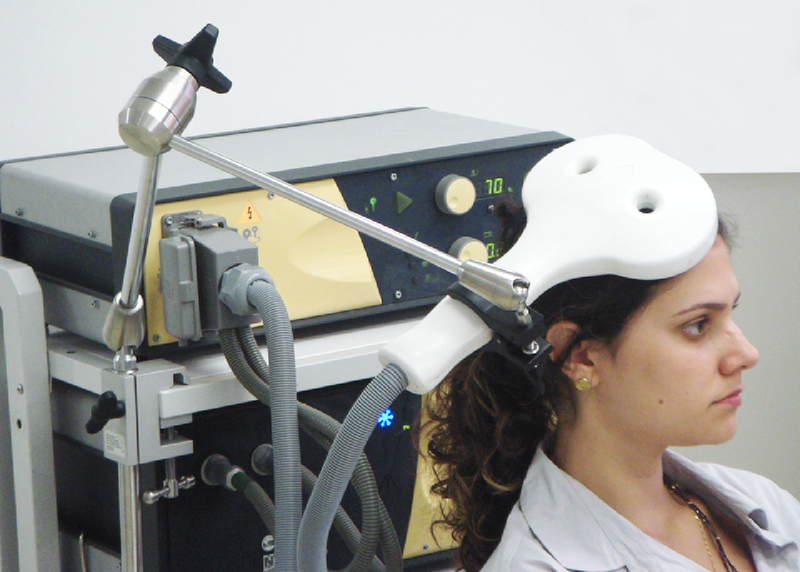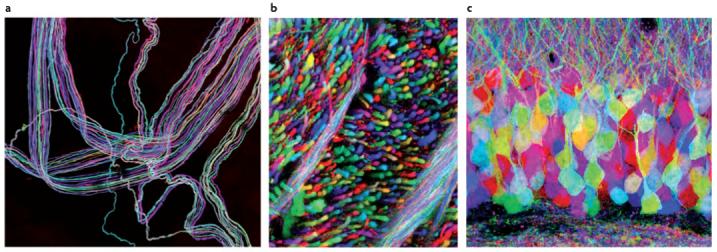Chapter 4: Research Methods in Biological Psychology
4.6: Techniques that Modulate Brain Activity
Neuroimaging studies focus on correlations between brain activity and behavior and can’t establish a causal role of a brain region in determining behavior. In order to establish a causal rather than correlational relationship, we need to alter brain function and observe subsequent change in behavior. Lesions are one way to alter the brain and can reveal a casual relationship (e.g., when losing a brain region leads to loss of function, that brain area is necessary or involved in the function). However, invasive lesions can only be introduced in animals, which differ from humans in key ways. Lesions in human brains can only be studied in patient populations; that is, after a patient experiences brain damage from a stroke or other injury. New technologies have been developed that allow researchers to temporarily and non-invasively alter brain function in humans.
Transcranial magnetic stimulation (TMS) is a form of brain stimulation that uses magnets to alter brain activity. Researchers place a magnetic coil over the scalp and apply a magnetic current that stimulates the neurons below the magnetic coil (Figure 4.12). Depending on the type and rate of magnetic pulses, TMS can be used to temporarily “turn off” or “turn on” the brain area under the coil. In research domains, researchers might temporarily “turn off” or “turn on” parts of the frontal lobe and look at subsequent feelings of craving or emotion processing. TMS is also used in clinical or medical settings, and has been shown to be an effective treatment for some people with depression (Perera et al., 2016).

Transcranial direct current stimulation (tDCS) is similar to TMS except that it uses electrical current directly (rather than inducing it with magnetic pulses) via small electrodes on the skull (Beck & Tapia, 2023). A brain area is stimulated by a low current (equivalent to an AA battery) for an extended period of time. When used in combination with cognitive training, tDCS has been shown to improve performance of many cognitive functions such as mathematical ability, memory, attention, and coordination (e.g., Brasil-Neto, 2012; Feng et al., 2013; Kuo & Nitsche, 2012).
Gene Knockout is a genetic technique used in animals, wherein researchers remove or inactivate a specific gene. This allows researchers to study the function of that specific gene in a living organism and its effects on the phenotype. Gene knockout is considered a “loss-of-function mutation” (what function is lost after knocking out a specific gene?). Gene knockouts are used in many organisms including fruit flies, zebrafish, and mice. Studies with “knockout mice” have been extremely valuable in understanding the role of genes in brain development, neurological disease, cancer, immune disorders, and even the genes involved in bad breath (Pol et al., 2018). Gene Knock-in is a related technique, but instead of removing a gene, knock-in inserts a gene. Gene knock-in is considered a “gain-of-function mutation” (what function is gained after inserting this gene?).
Brainbow is another innovative transgenic technique (transgenic means transferring genes from one organism to another) that inserts genetic material to label individual neurons with distinct colors and produces detailed neural maps. In brainbow, green fluorescent protein, a protein found in jellyfish and corals that exhibits bright green fluorescence, is mutated to produce different colors; these different color fluorescent proteins are inserted into individual neurons in different ratios to flag each neuron with a unique color (see Figure 4.13). Brainbow has enabled the simultaneous mapping of hundreds of neurons and allows scientists to trace the intricate connections between neurons. Thus, brainbow has been groundbreaking for the field of neural connectomics, which studies how neural networks are organized. The brainbow technique provides beautiful images of neurons and highlights biopsych research at the molecular and cellular level.

Optogenetics is an especially exciting technique to change brain activity in non-human animals (Deisseroth, 2011). Optogenetics uses light to control specific populations of neurons in living animals. For the neurons to be sensitive to light, researchers genetically insert light-sensitive proteins (taken from algae) into a specific type of neuron. After inserting tiny optical fibers into the animal’s brain, researchers can turn on the light to excite or inhibit these specific cells. Scientists have used the ability to control the activity of a genetically defined set of neurons to understand their contribution to learning, memory, decision making, addiction, movement, and many other active research areas.
In sum, the various research techniques used in biological psychology each have their own strengths and weaknesses in terms of spatial resolution, temporal resolution, ease-of-use, invasiveness, cost, precision, etc. Using the different tools in a complementary manner provides converging evidence for understanding how the brain works.
Text Attributions
This section contains material adapted from:
Beck, D. & Tapia, E. (2023). The brain. In R. Biswas-Diener & E. Diener (Eds), Noba textbook series: Psychology. Access for free at http://noba.to/jx7268sd License: CC BY-NC-SA 4.0 DEED
Biswas-Diener, R. (2023). The brain and nervous system. In R. Biswas-Diener & E. Diener (Eds), Noba textbook series: Psychology. Access for free at http://noba.to/4hzf8xv6 License: CC BY-NC-SA 4.0 DEED
A neuroscience technique whereby a brief magnetic pulse is applied to the head that temporarily activates or inhibits ongoing neuronal activity.
A neuroscience technique whereby a weak current is applied to the head that temporarily activates or inhibits ongoing neuronal activity.
A research technique that involves removing or inactivating a specific gene in an organism (often a fruit fly, zebrafish, or mouse), which allows researchers to study the effect of that gene on the phenotype.
A research technique that involves inserting a specific gene in an organism, which allows researchers to study the effect of that gene on the phenotype.
A genetic technique in which individual neurons can be labeled and mapped using fluorescent proteins.
A biological technique to control the activity of neurons or other cell types with light.
